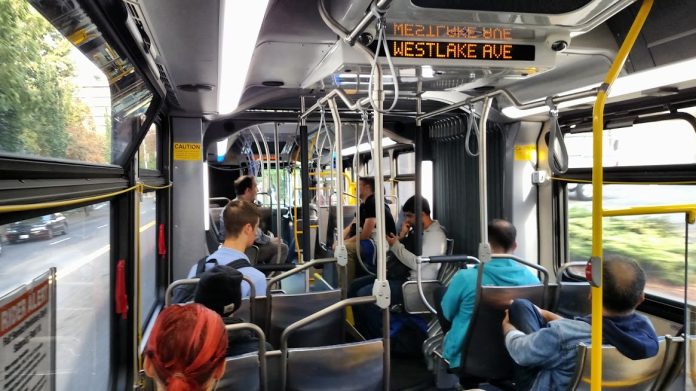Yesterday King County Metro announced broad service cuts affecting nearly every route starting on Monday March 23, while Sound Transit is also reducing service and the Monorail is already shut down. Link light rail will operate at 14-minute headways, the same frequency that it had been operating on for months due to scheduled track work.
That work–dubbed Connect 2020–will allow East Link, which is scheduled to open in 2023, to share track in the Downtown Seattle Transit Tunnel before branching eastward to Bellevue. The completion of Connect 2020 was supposed to allow a return to frequent headways, but then the COVID-19 intervened.
Transit ridership is plummeting in the Puget Sound Region and nationwide (Transit App is tracking the extent) as an increasing number of people heed the call to social distance–or find themselves laid off whether they like it or not.
“Many of Metro’s riders have heeded the steps advised by leaders and public health officials in recent weeks to limit the spread of novel coronavirus by teleworking and avoiding traveling,” Metro’s Sean Hawks wrote on Metro Matters blog. “Bus ridership on Wednesday, March 18, for example, was 60% less than a comparable day in 2019–a reduction of 250,000 passengers.”
Likewise, Sound Transit said its systemwide ridership was down 69%. With such greatly reduced demand, the agency decided it would be OK to slash service on its express bus routes and reduce Sounder train service.
While Community Transit is seeing a similar cratering of ridership, it is taking a different tack. The Snohomish County-based agency announced it was making transit fare free and introducing back-door boarding to reduce the opportunities for virus transmission and maintaining service levels for the time being. Shortly after this story went to post, King County Metro joined suit suspending fare collection indefinitely starting Saturday and asking passengers to board at the backdoor unless they need to use the ramp at the front. This will reduce risk to the bus drivers. Sound Transit joined in suspending fares on all its services shortly thereafter.
Pierce Transit has yet to announce service changes, although it has made some changes to promote social distancing onboard and, like other agencies, has stepped up sanitizing efforts.
Almost every single King County Metro route will operate less frequently starting Monday. Metro will also entire eliminate routes 9, 29, 47, 78, 125, 200, 208, 237, 308, 330, 541 until further notice. High-cost shuttle services Community Ride and Via to Transit have been axed, too. Via was previously scheduled to stop running at the end of April.
Unfortunately the cuts and the loss of Route 9 will make it harder for some workers to get to First Hill, which hosts three major hospitals and will be the epicenter of the region’s response to the pandemic. The First Hill Streetcar will continue to operate, but will stop running after 8:30pm. The South Lake Union Streetcar will stop running entirely.
Among other agencies, Intercity Transit is reducing cross county service and already moved to fare-free transit for separate reasons. Kitsap Transit is restricting passenger loads on its ferries. Washington State Ferries are suspending the recently resurrected Vancouver Island-Anacortes service as the Canadian border is closed save for trade and essential trips.
The loss of rider revenue is going to blow holes in many transit agencies budgets. The service cuts may lessen the damage, but it’s likely agencies will still need emergency assistance since sales tax revenue is also going to be decimated by the economic slowdown.
The advocacy group Transportation for America is circulating a petition to congressional leaders calling for emergency assistance to public transit providers nationwide. The Urbanist signed and we encourage you to sign, too.
“Public transit agencies are experiencing significant decreases in ridership and farebox revenue, while simultaneously incurring increased costs for additional cleaning,” Transportation for America wrote. “Without federal financial assistance, many transit agencies and paratransit service providers will be forced to dramatically reduce or eliminate critical service. This could cut off health care and other workers from jobs, and further harm economic output.”
The American Public Transportation Association (APTA) is asking for just shy of $13 billion which is a third of what US airlines are asking for despite employing roughly the same number of people. I’d argue transit is surely the higher priority than bailing out private companies–particularly those that squandered their tax breaks and economic boom years on stock buybacks to boost their stock price rather than invest in themselves or in increasing rainy day funds.
We need to keep transit operating in these trying times, and transit agencies must be ready to bounce back from this crisis and regain momentum. King County’s ballot measure for bus service was shelved, but Seattle will need to decide the fate of its own Transit Benefit District or face the possibility of massive permanent service cuts next year. In 2014, 62% of Seattle residents voted to increase bus service but things look very different now. Currently 350,000 annual service hours are funded by the Seattle benefit district, 8% of the entire network.
Emissions are also likely down during the pandemic, and perhaps we can keep carbon pollution from spiking to their previous unsustainable levels when the pandemic is behind us.
Doug Trumm is publisher of The Urbanist. An Urbanist writer since 2015, he dreams of pedestrian streets, bus lanes, and a mass-timber building spree to end our housing crisis. He graduated from the Evans School of Public Policy and Governance at the University of Washington in 2019. He lives in Seattle's Fremont neighborhood and loves to explore the city by foot and by bike.



